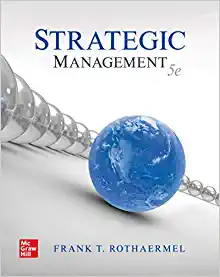1. Apply the ERRC (Eliminate, Reduce, Raise, Create) framework to Marvel Studios and the way they set up the business (set this up as a figure and explanations). Explain also how those ERRC choices allowed them to break the cost-value tradeoff. 2. Compare and contrast Marvels movie studio (started in 2006) with the traditional Hollywood style movie studio. To show this comparison create a Value Curve figure (include this figure in the submission) with the as is and to be parts (in the same figure). In your accompanying paragraph, discuss each x-axis item, how Marvel differs from Hollywood, and why Marvel made each choice.
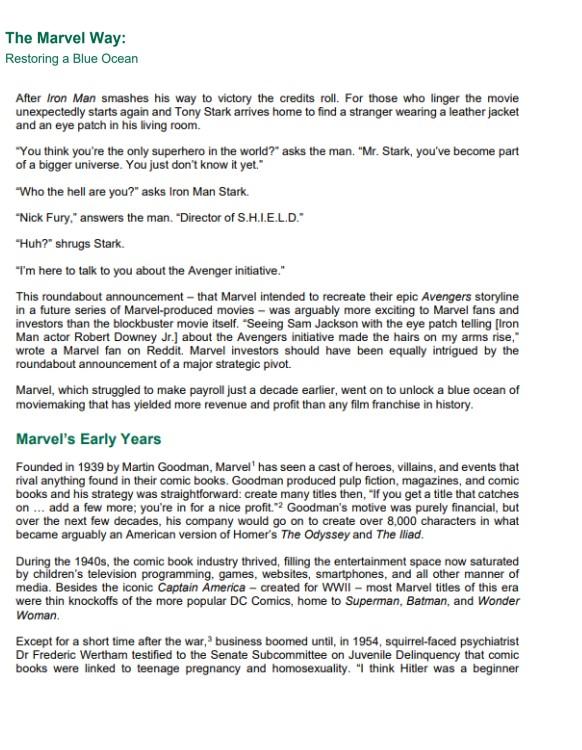
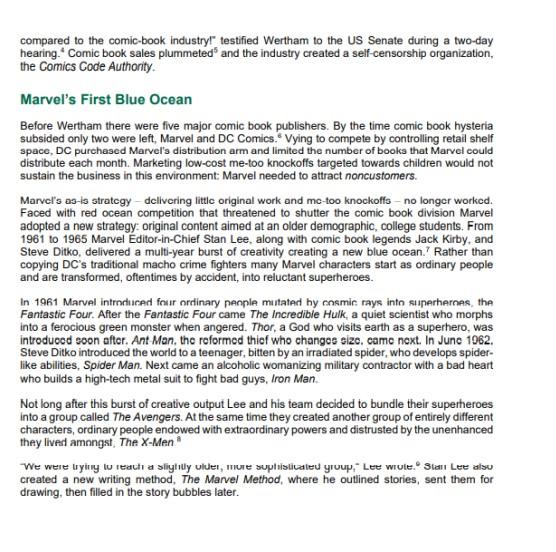
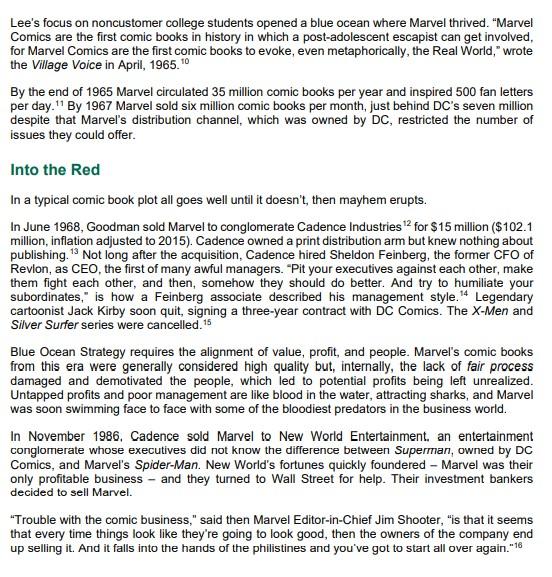
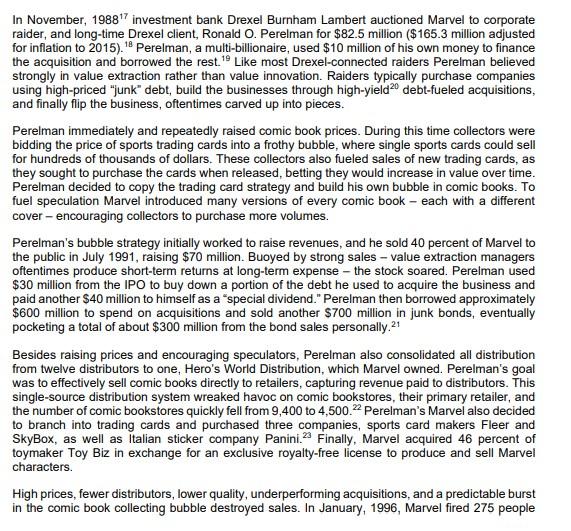

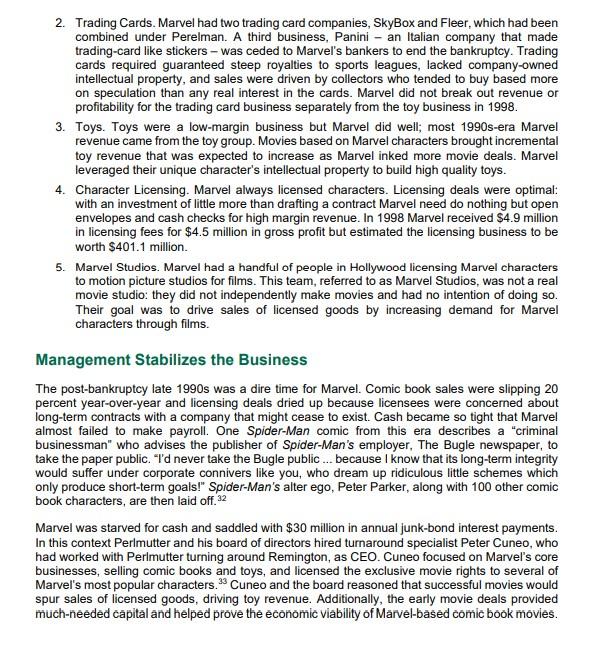
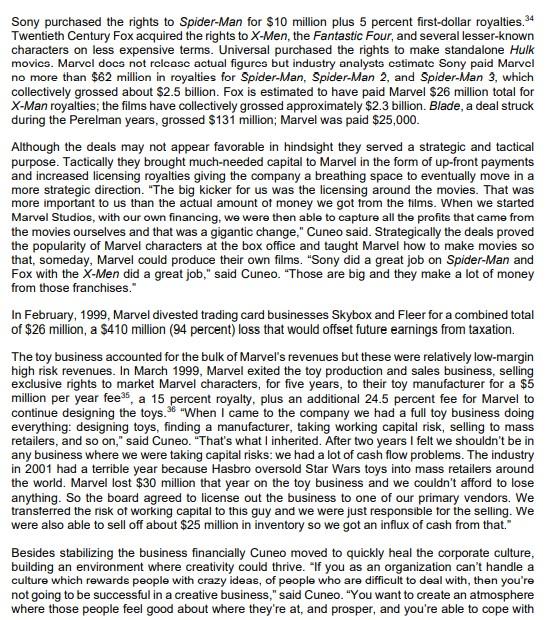
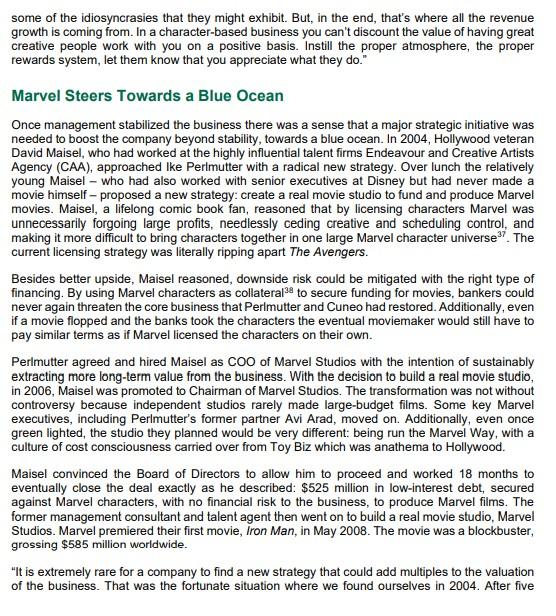
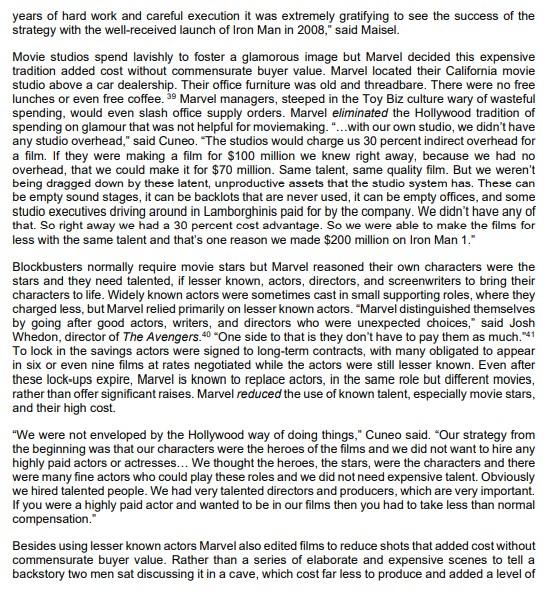
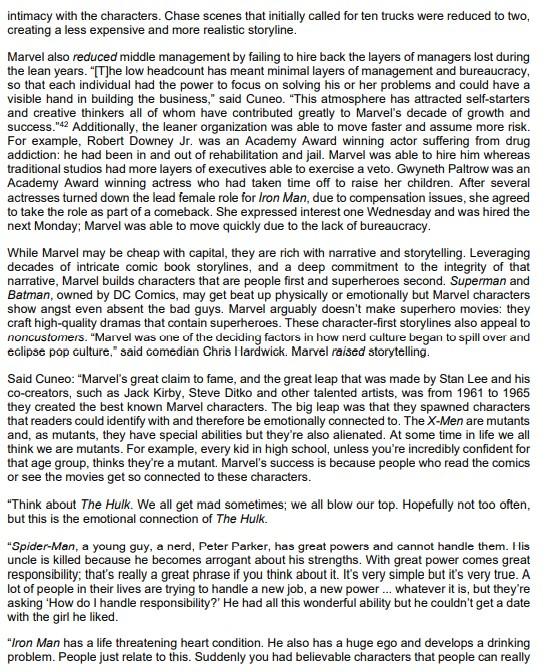

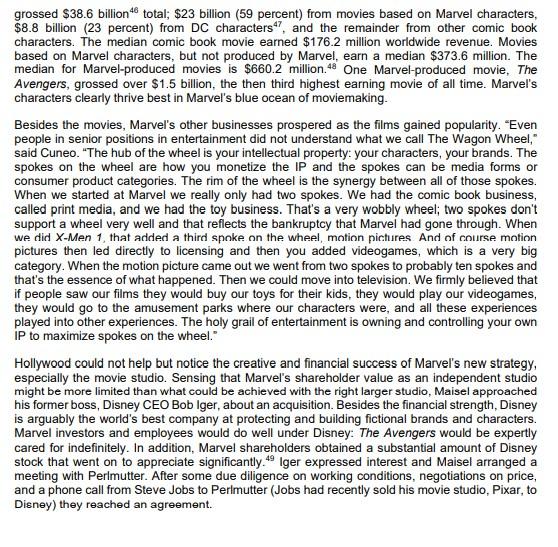
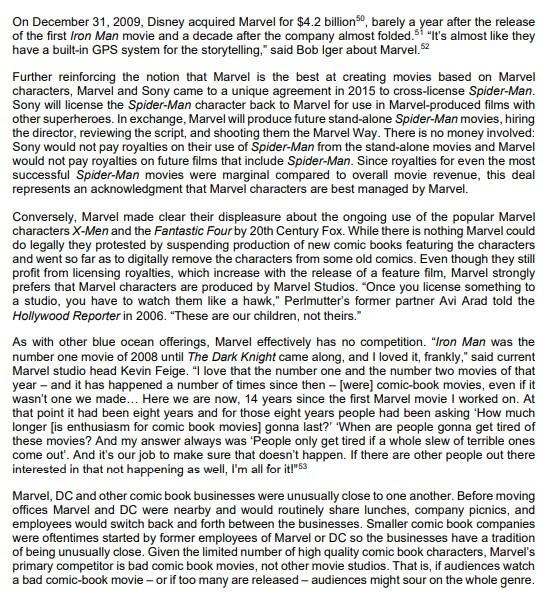
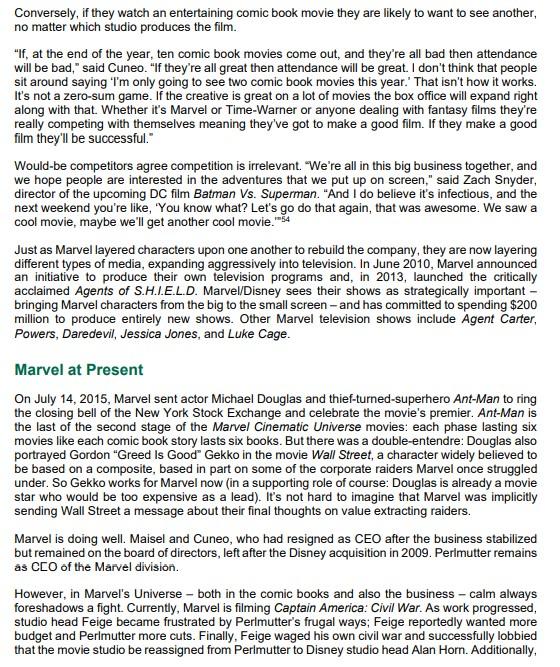
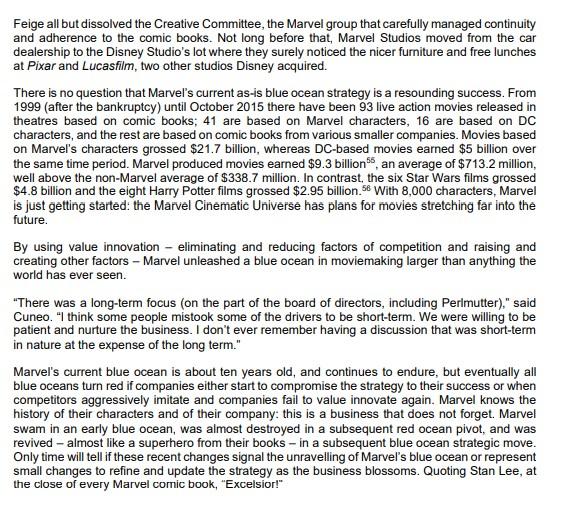
The Marvel Way: Restoring a Blue Ocean After Iron Man smashes his way to victory the credits roll. For those who linger the movie unexpectedly starts again and Tony Stark arrives home to find a stranger wearing a leather jacket and an eye patch in his living room. "You think you're the only superhero in the world?" asks the man. "Mr. Stark, you've become part of a bigger universe. You just don't know it yet," "Who the hell are you?" asks Iron Man Stark. "Nick Fury." answers the man. "Director of S.H.I.E.L.D." "Huh?" shrugs Stark. "Tm here to talk to you about the Avenger initiative." This roundabout announcement - that Marvel intended to recreate their epic Avengers storyline in a future series of Marvel-produced movies - was arguably more exciting to Marvel fans and investors than the blockbuster movie itself. "Seeing Sam Jackson with the eye patch telling flron Man actor Robert Downey Jr.] about the Avengers initiative made the hairs on my arms rise," wrote a Marvel fan on Reddit. Marvel investors should have been equally intrigued by the roundabout announcement of a major strategic pivot. Marvel, which struggled to make payroll just a decade earlier, went on to unlock a blue ocean of moviemaking that has yielded more revenue and profit than any film franchise in history. Marvel's Early Years Founded in 1939 by Martin Goodman, Marvel' 1 has seen a cast of heroes, villains, and events that rival anything found in their comic books. Goodman produced pulp fiction, magazines, and comic books and his strategy was straightforward: create many titles then, "If you get a title that catches on ... add a few more; you're in for a nice profit. 2 Goodman's motive was purely financial, but over the next few decades, his company would go on to create over 8,000 characters in what became arguably an American version of Homer's The Odyssey and The lliad. During the 1940s, the comic book industry thrived, filling the entertainment space now saturated by children's television programming, games, websites, smartphones, and all other manner of media. Besides the iconic Captain America - created for WWII - most Marvel titles of this era were thin knockoffs of the more popular DC Comics, home to Superman, Batman, and Wonder Woman. Except for a short time after the war, 3 business boomed until, in 1954, squirre-faced psychiatrist Dr Frederic Wertham testified to the Senate Subcommittee on Juvenile Delinquency that comic books were linked to teenage pregnancy and homosexuality. "I think Hitler was a beginner compared to the comic-book industryl" testified Wertham to the US Senate during a two-day hearing. 4 Comic book sales plummeted 5 and the industry created a self-censorship organization, the Comics Code Authority. Marvel's First Blue Ocean Before Wertham there were five major comic book publishers. By the time comic book hysteria subsided only two were left, Marvel and DC Comics. 6 Vying to compete by controlling retail shelf space, DC purehased Marvel's distribution arm and limited the number of books that Marvel could distribute each month. Marketing low-cost me-too knockoffs targeted towards children would not sustain the business in this environment: Marvel needed to attract noncustomers. Marvel's as-is strategy - delivering little original work and me-too knockoffs - no longer worked. Faced with red ocean competition that threatened to shutter the comic book division Marvel adopted a new strategy: original content aimed at an older demographic, college students. From 1961 to 1965 Marvel Editor-in-Chief Stan Lee, along with comic book legends Jack Kirby, and Steve Ditko, delivered a multi-year burst of creativity creating a new blue ocean. 7 Rather than copying DC's traditional macho crime fighters many Marvel characters start as ordinary people and are transformed, oftentimes by accident, into reluctant superheroes. In 1961 Marval introduced four ordinary penple mutated hy sosmic rays into sunerhernes, the Fantastic Four. After the Fantastic Four came The Incredible Hulk, a quiet scientist who morphs into a ferocious green monster when angered. Thor, a God who visits earth as a superhero, was introdueed soon after. Ant Man, the reformed thief who changee size. eame next. In June 1962. Steve Ditko introduced the world to a teenager, bitten by an irradiated spider, who develops spiderlike abilities, Spider Man. Next came an alcoholic womanizing military contractor with a bad heart who builds a high-tech metal suit to fight bad guys, Iron Man. Not long after this burst of creative output Lee and his team decided to bundle their superheroes into a group called The Avengers. At the same time they created another group of entirely different characters, ordinary people endowed with extraordinary powers and distrusted by the unenhanced they livesd amnngst, The X-Men " We were trying to tedati a sligitily ulder, mure suplisticated yruup," Lee wrule. "Slanl Lee also created a new writing method, The Marvel Method, where he outlined stories, sent them for drawing, then filled in the story bubbles later. Lee's focus on noncustomer college students opened a blue ocean where Marvel thrived. "Marvel Comics are the first comic books in history in which a post-adolescent escapist can get involved, for Marvel Comics are the first comic books to evoke, even metaphorically, the Real World," wrote the Village Voice in April, 1965.10 By the end of 1965 Marvel circulated 35 million comic books per year and inspired 500 fan letters per day. 11 By 1967 Marvel sold six million comic books per month, just behind DC's seven million despite that Marvel's distribution channel, which was owned by DC, restricted the number of issues they could offer. Into the Red In a typical comic book plot all goes well until it doesn't, then mayhem erupts. In June 1968, Goodman sold Marvel to conglomerate Cadence Industries 12 for $15 million ( $102.1 million, inflation adjusted to 2015). Cadence owned a print distribution arm but knew nothing about publishing. 13 Not long after the acquisition, Cadence hired Sheldon Feinberg, the former CFO of Revion, as CEO, the first of many awful managers. "Pit your executives against each other, make them fight each other, and then, somehow they should do better. And try to humiliate your subordinates," is how a Feinberg associate described his management style. 14 Legendary cartoonist Jack Kirby soon quit, signing a three-year contract with DC Comics. The X-Men and Silver Surfer series were cancelled. 15 Blue Ocean Strategy requires the alignment of value, profit, and people. Marvel's comic books from this era were generally considered high quality but, internally, the lack of fair process damaged and demotivated the people, which led to potential profits being left unrealized. Untapped profits and poor management are like blood in the water, attracting sharks, and Marvel was soon swimming face to face with some of the bloodiest predators in the business world. In November 1986. Cadence sold Marvel to New World Entertainment. an entertainment conglomerate whose executives did not know the difference between Superman, owned by DC Comics, and Marvel's Spider-Man. New World's fortunes quickly foundered - Marvel was their only profitable business - and they turned to Wall Street for help. Their investment bankers decided to sell Marvel. "Trouble with the comic business," said then Marvel Editor-in-Chief Jim Shooter, "is that it seems that every time things look like they're going to look good, then the owners of the company end up selling it. And it falls into the hands of the philistines and you've got to start all over again.. 16 In November, 198817 investment bank Drexel Burnham Lambert auctioned Marvel to corporate raider, and long-time Drexel client, Ronald O. Perelman for $82.5 million ( $165.3 million adjusted for inflation to 2015). 18 Perelman, a multi-billionaire, used $10 million of his own money to finance the acquisition and borrowed the rest. 19 Like most Drexel-connected raiders Perelman believed strongly in value extraction rather than value innovation. Raiders typically purchase companies using high-priced "junk" debt, build the businesses through high-yield 20 debt-fueled acquisitions, and finally flip the business, oftentimes carved up into pieces. Perelman immediately and repeatedly raised comic book prices. During this time collectors were bidding the price of sports trading cards into a frothy bubble, where single sports cards could sell for hundreds of thousands of dollars. These collectors also fueled sales of new trading cards, as they sought to purchase the cards when released, betting they would increase in value over time. Perelman decided to copy the trading card strategy and build his own bubble in comic books. To fuel speculation Marvel introduced many versions of every comic book - each with a different cover - encouraging collectors to purchase more volumes. Perelman's bubble strategy initially worked to raise revenues, and he sold 40 percent of Marvel to the public in July 1991, raising $70 million. Buoyed by strong sales - value extraction managers oftentimes produce short-term returns at long-term expense - the stock soared. Perelman used $30 million from the IPO to buy down a portion of the debt he used to acquire the business and paid another $40 million to himself as a "special dividend." Perelman then borrowed approximately $600 million to spend on acquisitions and sold another $700 million in junk bonds, eventually pocketing a total of about $300 million from the bond sales personally. 21 Besides raising prices and encouraging speculators, Perelman also consolidated all distribution from twelve distributors to one, Hero's World Distribution, which Marvel owned. Perelman's goal was to effectively sell comic books directly to retailers, capturing revenue paid to distributors. This single-source distribution system wreaked havoc on comic bookstores, their primary retailer, and the number of comic bookstores quickly fell from 9,400 to 4,500. 22 Perelman's Marvel also decided to branch into trading cards and purchased three companies, sports card makers Fleer and SkyBox, as well as Italian sticker company Panini. 23 Finally, Marvel acquired 46 percent of toymaker Toy Biz in exchange for an exclusive royalty-free license to produce and sell Marvel characters. High prices, fewer distributors, lower quality, underperforming acquisitions, and a predictable burst in the comic book collecting bubble destroyed sales. In January, 1996, Marvel fired 275 people then followed-up in November by firing another 115 , one third of its workforce. On December 27 , 1996 Marvel filed for bankruptcy: Marvel's red ocean strategy had run its course. For nineteen months, various groups fought for the business. Perelman, legendary corporate raider Carl Icahnn 24, Marvel's banks, Marvel bondholders 25, Marvel subsidiary Toy Biz, and a few other parties wanted Marvel. Perelman offered creditors $365 million, leaving Perelman owning about 80 percent of Marvel, with the public, bondholders, and bankers owning the other 20 percent. 26 Icahn, who briefly took control of the business 27, offered creditors similar terms with a different management team. Toy Biz majority owners Isaac Perimutter and Avi Arad offered $231.8 million cash, 40 percent of restructured Marvel, the Italian sticker company, and a strategy to return the company to profitability. Creditors voted to accept the Toy Biz offer even though the cash was $100 million less, due to Perlmutter and Arad's strategy and vision. 28 Even when battling billionaires a solid strategic vision can prevail over cash. 29 Perlmutter and Arad - low on cash but high on chutzpah with their strategic vision - prevailed over the battling billionaires. Perelman told the New York Times if he had to rank his successes Marvel would not be included. Icahn said "I have framed articles of every deal I've ever done. In all honesty, this is one frame l'm considering taking down." 30 On October 1, 1998, with approval of the court and creditors, Toy Biz, Inc. used $250 million in high-yield debt (junk bonds) to acquire the assets of the former Marvel and renamed itself Marvel Enterprises. 31 Perlmutter's Marvel now faced the daunting task of resuscitating the struggling business and executing their strategy. Evaluating Post-Bankruptcy Marvel After bankruptcy, in late 1998, Marvel had five high-level businesses: 1. Comic books. Marvel's flagship comic book business produced direct revenue and vast intangible assets: intellectual property, decades of characters, storylines, brand, customer goodwill, and an institutional knowledge about how to weave their IP into great stories. Marvel estimated the intangibles of their comic book business to be worth $127.7 million. 2. Trading Cards. Marvel had two trading card companies, SkyBox and Fleer, which had been combined under Perelman. A third business, Panini - an Italian company that made trading-card like stickers - was ceded to Marvel's bankers to end the bankruptcy. Trading cards required guaranteed steep royalties to sports leagues, lacked company-owned intellectual property, and sales were driven by collectors who tended to buy based more on speculation than any real interest in the cards. Marvel did not break out revenue or profitability for the trading card business separately from the toy business in 1998. 3. Toys. Toys were a low-margin business but Marvel did well; most 1990s-era Marvel revenue came from the toy group. Movies based on Marvel characters brought incremental toy revenue that was expected to increase as Marvel inked more movie deals. Marvel leveraged their unique character's intellectual property to build high quality toys. 4. Character Licensing. Marvel always licensed characters. Licensing deals were optimal: with an investment of little more than drafting a contract Marvel need do nothing but open envelopes and cash checks for high margin revenue. In 1998 Marvel received $4.9 million in licensing fees for $4.5 million in gross profit but estimated the licensing business to be worth $401.1 million. 5. Marvel Studios. Marvel had a handful of people in Hollywood licensing Marvel characters to motion picture studios for films. This team, referred to as Marvel Studios, was not a real movie studio: they did not independently make movies and had no intention of doing so. Their goal was to drive sales of licensed goods by increasing demand for Marvel characters through films. Management Stabilizes the Business The post-bankruptcy late 1990 s was a dire time for Marvel. Comic book sales were slipping 20 percent year-over-year and licensing deals dried up because licensees were concemed about long-term contracts with a company that might cease to exist. Cash became so tight that Marvel almost failed to make payroll. One Spider-Man comic from this era describes a "criminal businessman" who advises the publisher of Spider-Man's employer, The Bugle newspaper, to take the paper public. "I'd never take the Bugle public ... because I know that its long-term integrity would suffer under corporate connivers like you, who dream up ridiculous little schemes which only produce short-term goals!" Spider-Man's alter ego, Peter Parker, along with 100 other comic book characters, are then laid off. 32 Marvel was starved for cash and saddled with $30 million in annual junk-bond interest payments. In this context Perlmutter and his board of directors hired turnaround specialist Peter Cuneo, who had worked with Perimutter turning around Remington, as CEO. Cuneo focused on Marvel's core businesses, selling comic books and toys, and licensed the exclusive movie rights to several of Marvel's most popular characters. 33 Cuneo and the board reasoned that successful movies would spur sales of licensed goods, driving toy revenue. Additionally, the early movie deals provided much-needed capitl and helped provee the ecconomic viability of Mrvl-basd comic book movies. Sony purchased the rights to Spider-Man for $10 million plus 5 percent first-dollar royalties. 34 Twentieth Century Fox acquired the rights to X-Men, the Fantastic Four, and several lesser-known characters on less expensive terms. Universal purchased the rights to make standalone Hulk movics. Marvel docs not release actual figures but industry analysts cstimate Sony paid Marvel no more than $62 million in royalties for Spider-Man, Spider-Man 2, and Spider-Man 3, which collectively grossed about $2.5 billion. Fox is estimated to have paid Marvel $26 million total for X-Man royalties; the films have collectively grossed approximately $2.3 billion. Blade, a deal struck during the Perelman years, grossed $131 million; Marvel was paid $25,000. Although the deals may not appear favorable in hindsight they served a strategic and tactical purpose. Tactically they brought much-needed capital to Marvel in the form of up-front payments and increased licensing royalties giving the company a breathing space to eventually move in a more strategic direction. "The big kicker for us was the licensing around the movies. That was more important to us than the actual amount of money we got from the films. When we started Marvel Studios, with our own financing, we were then able to capture all the profits that came from the movies ourselves and that was a gigantic change," Cuneo said. Strategically the deals proved the popularity of Marvel characters at the box office and taught Marvel how to make movies so that, someday, Marvel could produce their own films. "Sony did a great job on Spider-Man and Fox with the X-Men did a great job," said Cuneo. "Those are big and they make a lot of money from those franchises." In February, 1999, Marvel divested trading card businesses Skybox and Fleer for a combined total of $26 million, a \$410 million (94 percent) loss that would offset future earnings from taxation. The toy business accounted for the bulk of Marvel's revenues but these were relatively low-margin high risk revenues. In March 1999, Marvel exited the toy production and sales business, selling exclusive rights to market Marvel characters, for five years, to their toy manufacturer for a $5 million per year fee 35, a 15 percent royalty, plus an additional 24.5 percent fee for Marvel to continue designing the toys. 36 "When I came to the company we had a full toy business doing everything: designing toys, finding a manufacturer, taking working capital risk, selling to mass retailers, and so on," said Cuneo. "That's what I inherited. After two years I felt we shouldn't be in any business where we were taking capital risks: we had a lot of cash flow problems. The industry in 2001 had a terrible year because Hasbro oversold Star Wars toys into mass retailers around the world. Marvel lost $30 million that year on the toy business and we couldn't afford to lose anything. So the board agreed to license out the business to one of our primary vendors. We transterred the risk of working capital to this guy and we were just responsible for the selling. We were also able to sell off about $25 million in inventory so we got an influx of cash from that." Besides stabilizing the business financially Cuneo moved to quickly heal the corporate culture, building an environment where creativity could thrive. "If you as an organization can't handle a culture which rewards people with crazy ideas, of people who are difficult to deal with, then you're not going to be successful in a creative business," said Cuneo. "You want to create an atmosphere where those people feel good about where they're at, and prosper, and you're able to cope with some of the idiosyncrasies that they might exhibit. But, in the end, that's where all the revenue growth is coming from. In a character-based business you can't discount the value of having great creative people work with you on a positive basis. Instill the proper atmosphere, the proper rewards system, let them know that you appreciate what they do." Marvel Steers Towards a Blue Ocean Once management stabilized the business there was a sense that a major strategic initiative was needed to boost the company beyond stability, towards a blue ocean. In 2004, Hollywood veteran David Maisel, who had worked at the highly influential talent firms Endeavour and Creative Artists Agency (CAA), approached Ike Perlmutter with a radical new strategy. Over lunch the relatively young Maisel - who had also worked with senior executives at Disney but had never made a movie himself - proposed a new strategy: create a real movie studio to fund and produce Marvel movies. Maisel, a lifelong comic book fan, reasoned that by licensing characters Marvel was unnecessarily forgoing large profits, needlessly ceding creative and scheduling control, and making it more difficult to bring characters together in one large Marvel character universe 3. The current licensing strategy was literally ripping apart The Avengers. Besides better upside, Maisel reasoned, downside risk could be mitigated with the right type of financing. By using Marvel characters as collateral 38 to secure funding for movies, bankers could never again threaten the core business that Perlmutter and Cuneo had restored. Additionally, even if a movie flopped and the banks took the characters the eventual moviemaker would still have to pay similar terms as if Marvel licensed the characters on their own. Perlmutter agreed and hired Maisel as COO of Marvel Studios with the intention of sustainably extracting more long-term value from the business. With the decision to build a real movie studio, in 2006, Maisel was promoted to Chairman of Marvel Studios. The transformation was not without controversy because independent studios rarely made large-budget films. Some key Marvel executives, including Perlmutter's former partner Avi Arad, moved on. Additionally, even once green lighted, the studio they planned would be very different: being run the Marvel Way, with a culture of cost consciousness carried over from Toy Biz which was anathema to Hollywood. Maisel convinced the Board of Directors to allow him to proceed and worked 18 months to eventually close the deal exactly as he described: $525 million in low-interest debt, secured against Marvel characters, with no financial risk to the business, to produce Marvel films. The former management consultant and talent agent then went on to build a real movie studio, Marvel Studios. Marvel premiered their first movie, Iron Man, in May 2008. The movie was a blockbuster, grossing $585 million worldwide. "It is extremely rare for a company to find a new strategy that could add multiples to the valuation of the business. That was the fortunate situation where we found ourselves in 2004. After five years of hard work and careful execution it was extremely gratifying to see the success of the strategy with the well-received launch of Iron Man in 2008," said Maisel. Movie studios spend lavishly to foster a glamorous image but Marvel decided this expensive tradition added cost without commensurate buyer value. Marvel located their California movie studio above a car dealership. Their office furniture was old and threadbare. There were no free lunches or even free coffee. 39 Marvel managers, steeped in the Toy Biz culture wary of wasteful spending, would even slash office supply orders. Marvel eliminated the Hollywood tradition of spending on glamour that was not helpful for moviemaking. "...with our own studio, we didn't have any studio overhead," said Cuneo. "The studios would charge us 30 percent indirect overhead for a film. If they were making a film for $100 million we knew right away, because we had no overhead, that we could make it for $70 million. Same talent, same quality film. But we weren't being dragged down by these latent, unproductive assets that the studio system has. These can be empty sound stages, it can be backlots that are never used, it can be empty offices, and some studio executives driving around in Lamborghinis paid for by the company. We didn't have any of that. So right away we had a 30 percent cost advantage. So we were able to make the films for less with the same talent and that's one reason we made $200 million on Iron Man 1." Blockbusters normally require movie stars but Marvel reasoned their own characters were the stars and they need talented, if lesser known, actors, directors, and screenwriters to bring their characters to life. Widely known actors were sometimes cast in small supporting roles, where they charged less, but Marvel relied primarily on lesser known actors. "Marvel distinguished themselves by going after good actors, writers, and directors who were unexpected choices," said Josh Whedon, director of The Avengers. 40 "One side to that is they don't have to pay them as much. .41 To lock in the savings actors were signed to long-term contracts, with many obligated to appear in six or even nine films at rates negotiated while the actors were still lesser known. Even after these lock-ups expire, Marvel is known to replace actors, in the same role but different movies, rather than offer significant raises. Marvel reduced the use of known talent, especially movie stars, and their high cost. "We were not enveloped by the Hollywood way of doing things," Cuneo said. "Our strategy from the beginning was that our characters were the heroes of the films and we did not want to hire any highly paid actors or actresses... We thought the heroes, the stars, were the characters and there were many fine actors who could play these roles and we did not need expensive talent. Obviously we hired talented people. We had very talented directors and producers, which are very important. If you were a highly paid actor and wanted to be in our films then you had to take less than normal compensation." Besides using lesser known actors Marvel also edited films to reduce shots that added cost without commensurate buyer value. Rather than a series of elaborate and expensive scenes to tell a backstory two men sat discussing it in a cave, which cost far less to produce and added a level of intimacy with the characters. Chase scenes that initially called for ten trucks were reduced to two, creating a less expensive and more realistic storyline. Marvel also reduced middle management by failing to hire back the layers of managers lost during the lean years. "[T]he low headcount has meant minimal layers of management and bureaucracy, so that each individual had the power to focus on solving his or her problems and could have a visible hand in building the business," said Cuneo. "This atmosphere has attracted self-starters and creative thinkers all of whom have contributed greatly to Marvel's decade of growth and success." 42 Additionally, the leaner organization was able to move faster and assume more risk. For example, Robert Downey Jr. was an Academy Award winning actor suffering from drug addiction: he had been in and out of rehabilitation and jail. Marvel was able to hire him whereas traditional studios had more layers of executives able to exercise a veto. Gwyneth Paltrow was an Academy Award winning actress who had taken time off to raise her children. After several actresses turned down the lead female role for Iron Man, due to compensation issues, she agreed to take the role as part of a comeback. She expressed interest one Wednesday and was hired the next Monday; Marvel was able to move quickly due to the lack of bureaucracy. While Marvel may be cheap with capital, they are rich with narrative and storytelling. Leveraging decades of intricate comic book storylines, and a deep commitment to the integrity of that narrative, Marvel builds characters that are people first and superheroes second. Superman and Batman, owned by DC Comics, may get beat up physically or emotionally but Marvel characters show angst even absent the bad guys. Marvel arguably doesn't make superhero movies: they craft high-quality dramas that contain superheroes. These character-first storylines also appeal to noncustomers. "Marvel was one of the deciding factors in how nerd culture began to spill over and eclipse pop culture," said comedian Chris Hardwick. Marvel raised storytelling. Said Cuneo: "Marvel's great claim to fame, and the great leap that was made by Stan Lee and his co-creators, such as Jack Kirby, Steve Ditko and other talented artists, was from 1961 to 1965 they created the best known Marvel characters. The big leap was that they spawned characters that readers could identify with and therefore be emotionally connected to. The X-Men are mutants and, as mutants, they have special abilities but they're also alienated. At some time in life we all think we are mutants. For example, every kid in high school, unless you're incredibly confident for that age group, thinks they're a mutant. Marvel's success is because people who read the comics or see the movies get so connected to these characters. "Think about The Hulk. We all get mad somtimes; we all blow our top. Hopefully not too oftn, but this is the emotional connection of The Hulk. "Spider-Man, a young guy, a nerd, Peter Parker, has great powers and cannot handle them. His uncle is killed because he becomes arrogant about his strengths. With great power comes great responsibility; that's really a great phrase if you think about it. It's very simple but it's very true. A lot of people in their lives are trying to handle a new job, a new power ... whatever it is, but they're asking 'How do I handle responsibility?' He had all this wonderful ability but he couldn't get a date with the girl he liked. "Iron Man has a life threatening heart condition. He also has a huge ego and develops a drinking problem. People just relate to this. Suddenly you had believable characters that people can really get excited about. That was the great leap that Marvel made and that was the leap that we wanted to make in film." Besides the characters themselves, the storylines appealed to noncustomers. Iron Man 1 is more love story than superhero movie. Love stories between a middle-aged arms dealer who flies around in a metal suit and a 30 -something woman are not standard Hollywood fare. Yet, with its appeal to noncustomers, the movie went on to gross $585 million in box office receipts worldwide. In Stan Lee's original Marvel Universe characters are interwoven between stories, allowing old "layering" characters upon one another, building the success of each new character with the success of preceding characters to ensure they were not too dependent on any single character. With the creation of the movie studio this evolved into a new creation, the Marvel Cinematic Universe, where characters support one another until they become strong enough for their own movie line, and also appear together in movies. Finally, Marvel created a Creative Committee to craft the films consisting of lead comic book editors and company executives to ensure the integrity of their characters and storylines. Rather than grant a carte blanche creative license for directors to bring comic books to life, Marvel executives retained this role for themselves, going so far as to replace traditional storyboards with cut-up comic books. Marvel is vested in the well-being of their characters, almost as a parent is to a child. In line with the husbandry of their characters Marvel producers are substantially more involved in the movie-making process, actively managing actors and directors to bring the Marvel vision to life, rather than relying upon the vision of an individual actor or director. 43 Via the Creative Committee Marvel created a cohesive storyline not dependent on any single actor or director. As discussed above, a vital key factor of competition was Marvel's decision to control their own destiny in the movie business. That decision, and the mechanism to do that - the $525 million non-recourse credit line 44 - enabled Marvel to unlock many other key factors and sail to their new blue ocean. Marvel Morphs into a Blue Ocean ... Again When Marvel character Bruce Banner becomes angry he transforms into The Hulk, a giant green monster that smashes anything in his way. Similarly, Marvel's misfortunes inspired a strategio pivot that quickly opened a blue ocean. One hundred and twenty-nine live-action feature-length movies, based on comic books, have been released in theaters since the first modern comic-book movie, Superman, in 1978.45 These films grossed $38.6 billion 46 total; $23 billion (59 percent) from movies based on Marvel characters, $8.8 billion (23 percent) from DC characters 47, and the remainder from other comic book characters. The median comic book movie earned $176.2 million worldwide revenue. Movies based on Marvel characters, but not produced by Marvel, earn a median $373.6 million. The median for Marvel-produced movies is $660.2 million. 48 One Marvel-produced movie, The Avengers, grossed over $1.5 billion, the then third highest earning movie of all time. Marvel's characters clearly thrive best in Marvel's blue ocean of moviemaking. Besides the movies, Marvel's other businesses prospered as the films gained popularity. "Even people in senior positions in entertainment did not understand what we call The Wagon Wheel," said Cuneo. "The hub of the wheel is your intellectual property: your characters, your brands. The spokes on the wheel are how you monetize the IP and the spokes can be media forms or consumer product categories. The rim of the wheel is the synergy between all of those spokes. When we started at Marvel we really only had two spokes. We had the comic book business, called print media, and we had the toy business. That's a very wobbly wheel; two spokes don't support a wheel very well and that reflects the bankruptcy that Marvel had gone through. When we did X-Men 1, that added a third spoke on the wheel, motion pictures. And of course motion pictures then led directly to licensing and then you added videogames, which is a very big category. When the motion picture came out we went from two spokes to probably ten spokes and that's the essence of what happened. Then we could move into television. We firmly believed that if people saw our films they would buy our toys for their kids, they would play our videogames, they would go to the amusement parks where our characters were, and all these experiences played into other experiences. The holy grail of entertainment is owning and controlling your own IP to maximize spokes on the wheel." Hollywood could not help but notice the creative and financial success of Marvel's new strategy, especially the movie studio. Sensing that Marvel's shareholder value as an independent studio might be more limited than what could be achieved with the right larger studio, Maisel approached his former boss, Disney CEO Bob Iger, about an acquisition. Besides the financial strength, Disney is arguably the world's best company at protecting and building fictional brands and characters. Marvel investors and employees would do well under Disney: The Avengers would be expertly cared for indefinitely. In addition, Marvel shareholders obtained a substantial amount of Disney stock that went on to appreciate significantly. 49 Iger expressed interest and Maisel arranged a meeting with Perlmutter. After some due diligence on working conditions, negotiations on price, and a phone call from Steve Jobs to Perlmutter (Jobs had recently sold his movie studio, Pixar, to Disney) they reached an agreement. On December 31,2009 , Disney acquired Marvel for $4.2 billion 50, barely a year after the release of the first Iron Man movie and a decade after the company almost folded. 51 "It's almost like they have a built-in GPS system for the storytelling," said Bob Iger about Marvel. 52 Further reinforcing the notion that Marvel is the best at creating movies based on Marvel characters, Marvel and Sony came to a unique agreement in 2015 to cross-license Spider-Man. Sony will license the Spider-Man character back to Marvel for use in Marvel-produced films with other superheroes. In exchange, Marvel will produce future stand-alone Spider-Man movies, hiring the director, reviewing the script, and shooting them the Marvel Way. There is no money involved: Sony would not pay royalties on their use of Spider-Man from the stand-alone movies and Marvel would not pay royalties on future films that include Spider-Man. Since royalties for even the most successful Spider-Man movies were marginal compared to overall movie revenue, this deal represents an acknowledgment that Marvel characters are best managed by Marvel. Conversely, Marvel made clear their displeasure about the ongoing use of the popular Marvel characters X-Men and the Fantastic Four by 20 th Century Fox. While there is nothing Marvel could do legally they protested by suspending production of new comic books featuring the characters and went so far as to digitally remove the characters from some old comics. Even though they still profit from licensing royalties, which increase with the release of a feature film, Marvel strongly prefers that Marvel characters are produced by Marvel Studios. "Once you license something to a studio, you have to watch them like a hawk," Perlmutter's former partner Avi Arad told the Hollywood Reporter in 2006 . "These are our children, not theirs." As with other blue ocean offerings, Marvel effectively has no competition. "Iron Man was the number one movie of 2008 until The Dark Knight came along, and I loved it, frankly," said current Marvel studio head Kevin Feige. "I love that the number one and the number two movies of that year - and it has happened a number of times since then - [were] comic-book movies, even if it wasn't one we made... Here we are now, 14 years since the first Marvel movie I worked on. At that point it had been eight years and for those eight years people had been asking 'How much longer [is enthusiasm for comic book movies] gonna last?' 'When are people gonna get tired of these movies? And my answer always was 'People only get tired if a whole slew of terrible ones come out'. And it's our job to make sure that doesn't happen. If there are other people out there interested in that not happening as well, I'm all for it!" 53 Marvel, DC and other comic book businesses were unusually close to one another. Before moving offices Marvel and DC were nearby and would routinely share lunches, company picnics, and employees would switch back and forth between the businesses. Smaller comic book companies were oftentimes started by former employees of Marvel or DC so the businesses have a tradition of being unusually close. Given the limited number of high quality comic book characters, Marvel's primary competitor is bad comic book movies, not other movie studios. That is, if audiences watch a bad comic-book movie - or if too many are released - audiences might sour on the whole genre. Conversely, if they watch an entertaining comic book movie they are likely to want to see another, no matter which studio produces the film. "If, at the end of the year, ten comic book movies come out, and they're all bad then attendance will be bad," said Cuneo. "If they're all great then attendance will be great. I don't think that people sit around saying 'I'm only going to see two comic book movies this year.' That isn't how it works. It's not a zero-sum game. If the creative is great on a lot of movies the box office will expand right along with that. Whether it's Marvel or Time-Warner or anyone dealing with fantasy films they're really competing with themselves meaning they've got to make a good film. If they make a good film they'll be successful." Would-be competitors agree competition is irrelevant. "We're all in this big business together, and we hope people are interested in the adventures that we put up on screen," said Zach Snyder, director of the upcoming DC film Batman Vs. Superman. "And I do believe it's infectious, and the next weekend you're like, 'You know what? Let's go do that again, that was awesome. We saw a cool movie, maybe we'll get another cool movie..'54 Just as Marvel layered characters upon one another to rebuild the company, they are now layering different types of media, expanding aggressively into television. In June 2010, Marvel announced an initiative to produce their own television programs and, in 2013, launched the critically acclaimed Agents of S.H.I.E.L.D. Marvel/Disney sees their shows as strategically important bringing Marvel characters from the big to the small screen - and has committed to spending $200 million to produce entirely new shows. Other Marvel television shows include Agent Carter, Powers, Daredevil, Jessica Jones, and Luke Cage. Marvel at Present On July 14, 2015, Marvel sent actor Michael Douglas and thief-turned-superhero Ant-Man to ring the closing bell of the New York Stock Exchange and celebrate the movie's premier. Ant-Man is the last of the second stage of the Marvel Cinematic Universe movies: each phase lasting six movies like each comic book story lasts six books. But there was a double-entendre: Douglas also portrayed Gordon "Greed Is Good" Gekko in the movie Wall Street, a character widely believed to be based on a composite, based in part on some of the corporate raiders Marvel once struggled under. So Gekko works for Marvel now (in a supporting role of course: Douglas is already a movie star who would be too expensive as a lead). It's not hard to imagine that Marvel was implicitly sending Wall Street a message about their final thoughts on value extracting raiders. Marvel is doing well. Maisel and Cuneo, who had resigned as CEO after the business stabilized but remained on the board of directors, left after the Disney acquisition in 2009 . Perimutter remains as C[O of the Marvel division. However, in Marvel's Universe - both in the comic books and also the business - calm always foreshadows a fight. Currently, Marvel is filming Captain America: Civil War. As work progressed, studio head Feige became frustrated by Perimutter's frugal ways; Feige reportedly wanted more budget and Perlmutter more cuts. Finally, Feige waged his own civil war and successfully lobbied that the movie studio be reassigned from Perimutter to Disney studio head Alan Horn. Additionally, Feige all but dissolved the Creative Committee, the Marvel group that carefully managed continuity and adherence to the comic books. Not long before that, Marvel Studios moved from the car dealership to the Disney Studio's lot where they surely noticed the nicer furniture and free lunches at Pixar and Lucasfilm, two other studios Disney acquired. There is no question that Marvel's current as-is blue ocean strategy is a resounding success. From 1999 (after the bankruptcy) until October 2015 there have been 93 live action movies released in theatres based on comic books; 41 are based on Marvel characters, 16 are based on DC characters, and the rest are based on comic books from various smaller companies. Movies based on Marvel's characters grossed $21.7 billion, whereas DC-based movies earned $5 billion over the same time period. Marvel produced movies earned $9.3 billion 55, an average of $713.2 million, well above the non-Marvel average of $338.7 million. In contrast, the six Star Wars films grossed $4.8 billion and the eight Harry Potter films grossed $2.95 billion. 56 With 8,000 characters, Marvel future. By using value innovation - eliminating and reducing factors of competition and raising and creating other factors - Marvel unleashed a blue ocean in moviemaking larger than anything the world has ever seen. "There was a long-term focus (on the part of the board of directors, including Perimutter)," said Cuneo. "I think some people mistook some of the drivers to be short-term. We were willing to be patient and nurture the business. I don't ever remember having a discussion that was short-term in nature at the expense of the long term." Marvel's current blue ocean is about ten years old, and continues to endure, but eventually all blue oceans turn red if companies either start to compromise the strategy to their success or when competitors aggressively imitate and companies fail to value innovate again. Marvel knows the history of their characters and of their company: this is a business that does not forget. Marvel swam in an early blue ocean, was almost destroyed in a subsequent red ocean pivot, and was revived - almost like a superhero from their books - in a subsequent blue ocean strategic move. Only time will tell if these recent changes signal the unravelling of Marvel's blue ocean or represent small changes to refine and update the strategy as the business blossoms. Quoting Stan Lee, at the close of every Marvel comic book, "Excelsior





















